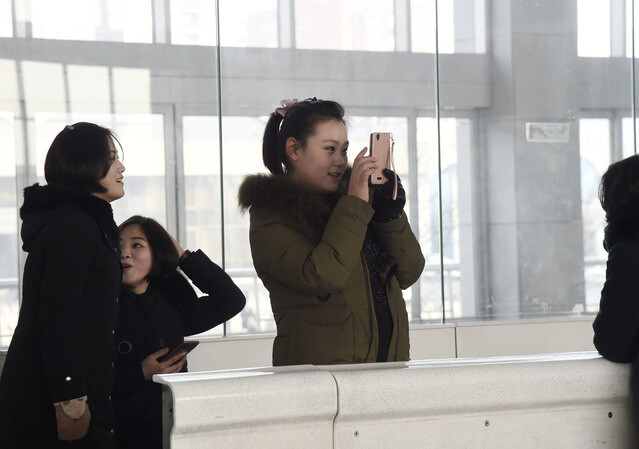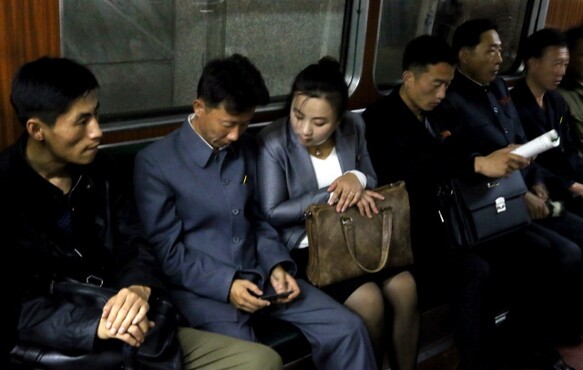hankyoreh
Links to other country sites 다른 나라 사이트 링크
Smartphones interwoven into all aspects of North Korean life

Smartphones – known locally as jineunghyeong son jeonhwagi, or “intelligent hand telephones” – have become an integral part of daily life for North Koreans. Evidence of this can be found with the app Kumbangul (Golden Bell) 1.0, which sets off an alarm whenever the device is separated from its user’s body. How do North Koreans make use of these now essential items? What sort of changes have they brought to North Korean society?
Phones turn the market wheels
“When I was doing business in Pyongyang, I had three smartphones. You use a smartphone to buy items [to sell] and confirm whether money has arrived correctly. You contact the service car driver [bringing items] and go out [to meet them] at the appointed time, and when the car arrives you take the items out. The driver sends texts and calls [by smartphone] to let you know their position and arrival time in real time. In sales, time is money. You have to have a smartphone,” said a former Pyongyang resident surnamed Jeong who defected to South Korea in 2017
“People who intend to make money need to have a phone, even if it means they have nothing to eat or spend on other things. Everyone is connected by smartphone,” said a woman in her forties who defected to South Korea in 2017

Mobile phones are essential items for North Korean merchants and businesspeople. The devices play a key role in the processes of selling locally made items in China, paying costs associated with purchases outside the North’s borders, and receiving the items and transporting them to the market for sale. Imagine a North Korean merchant who is importing Chinese items from the border region. Once the items arrive at the border, “Remittance Broker” – which functions as a kind of bank – texts or calls the merchant to notify him or her that the products are there. The merchant then accesses Remittance Broker to request the necessary payment. Thanks to mobile phones, prices can be established, products transported and cash transferred – all in real time.
“In Pyongyang, everyone has a mobile phone, even if they have nothing else,” said the aforementioned woman in her forties who defected to South Korea in 2017.
“At the markets, you have to call up and place an order at the right time when items [that you are selling] run low,” she explained.
Hong Min, director of the North Korea research office at the Korea Institute for National Unification (KINU), explained, “As recently as the early 2000s, mobile phones weren’t very widely available, so rice and corn prices differed from one region to the other.”
“But as mobile phones became increasingly widespread in the mid-aughts, national prices became established for products, and the price difference between the border and inland regions was no longer so large. The mobile phones created a market network,” he said.
Yang Moon-soo, a professor at the University of North Korean Studies, said, “Markets mature in a qualitative sense as regional price disparities disappear.”
“From the standpoint of someone making products, this enables economies of scale that increase productivity and efficiency,” Yang noted.
The phones have also generated a synergy effect in combination with so-called ssobicha, or “service cars.” A service car is a truck or van registered with the relevant institutions and authorities for use in transport and other purposes. Individuals provide service cars in exchange for a registration fee and portion of monthly earnings paid to the authorities. Jeong, the former merchant in Pyongyang, explained, “Service cars are used [in sales], and a driver or a person known in North Korea as a ‘hwaju’ [freight owner] rides along. You contact that person by mobile phone to share delivery information.”
In May 2018, the Korea Trade Promotion Corporation (KOTRA) cited the US-Korea Institute as saying that North Korean merchants were “detecting market trends and setting volumes and prices using mobile phones.” In particular, it noted that the combination of mobile phones and service cars had “generated a synergy innovation effect that is ushering in an era of ‘doing commerce while sitting down.’”
Mobile phones as indicators of social status and wealth
“In the old days, I’d meet with friends to have a drink or something. Since the smartphones started emerging, they play [smartphone] games together or watch movies and listen to music. Some people will sell everything they own if it will get them a smartphone.”
Jeong, the defector and former Pyongyang resident, said that smartphones are so popular that quite a few people own several of the devices. This means that while an individual is only able to register one device on a North Korean telecommunications network (Koryolink or Kang Song Net), some people will use others’ names as needed to set up multiple phones.
The types and number of models people own are another gauge of popularity.
“My friends who had gone into the military would call home asking their family to buy them a smartphone. I even saw some who insisted they wouldn’t go to school unless they had one,” said a North Korean woman in her 20s who arrived in the South in 2016.
“In the South, you can buy them in installments, but in the North you have to pay for them all at once,” she added. “That’s a lot of money, and a lot of my friends didn’t have one. There’s a lot of stress over whether or not you have a phone. The quality of a person’s life is sometimes rated by the model of phone they own.”
Hong Min explained, “What kind of phone you have is an indicator your wealth or family environment.”
“It’s also a tool for drawing distinctions,” he noted.
The phones have also brought changes to North Koreans’ lifestyle patterns and recreation culture. Users take selfies and use Bluetooth technology to enjoy games with friends. A Pyongyang 2423 acquired by the Hankyoreh – the latest model of North Korean smartphones, launched in October 2018 – included a card-playing app that allowed up to four people to play with Bluetooth. By accessing the North Korean internet and paying a fee, users can download hundreds of games along with various songs, videos and books. Also included were apps for checking a user’s blood pressure, pulse and other health readings and for managing crops. In addition, an internet of things is emerging, connecting mobile phones with objects online. A 2017 edition of “Higher Education” published by North Korea’s Education News included a piece titled “Smartphone-operated decorative lights.”
“Smartphones can be used according to alter the shape and color [of decorative lights] according to the user’s needs, and even adjust their brightness,” it noted.

Parents of NK students worried about phone addiction
“In North Korea, parents also start showing children’s movies and cartoons to their children around the age of three,” Jeong said.
“My nieces and nephews sometimes take their parents’ smartphone with them to play games at kindergarten, and whine if they don’t get it.”
Accounts from defectors and a search of the North Korean literature show a society where North Korean people also fret about the various side effects and societal issues stemming from smartphones. Between 2010 and 2012, the number of mobile communication subscribers in North Korea rose from around 500,000 to over one million; the same period saw the publication of pieces in North Korean magazines and other media warning of the dangers of indiscriminate smartphone use. A 2014 edition of the magazine “Art Education” published by 2.16 Art Education Press included a piece titled “Areas requiring caution in the use of mobile phones.”
“Signs of retinal detachment are appearing far more often among young people today,” it said.
“The cause lies in the frequent use of mobile phones at night,” it concluded.
The same year, the Labor Group Press magazine “Choson Woman” observed that “the use of mobile phones before sleeping can cause insomnia, headaches and diminished concentration.”

North Koreans can now order food and products on smartphones
North Korea has its own food delivery apps allowing smartphone users to order food. E-commerce also looks to be taking off, with working mothers using smartphone apps to shop. An April 2015 edition of the General Association of Korean Residents in Japan (Chongryon) newspaper Choson Sinbo reported on an app called “Okryu.” Smartphone users who accessed the network would be able to join Okryu and search for and even purchase products as of February that year, it explained. In addition to ordering various types of food, the app could also be used to purchase domestically produced items including food, cosmetics, medicine, shoes and handbags. In particular, the newspaper noted that Okryu could be used to order the famous restaurant Okryu-gwan’s Pyongyang cold noodles – its premier dish.
“Among working mothers in particular, it is seen as a convenient way to purchase necessary items without going to the store,” the newspaper said.
By Noh Ji-won and Kim Ji-eun, staff reporters
Please direct comments or questions to [english@hani.co.kr]

Editorial・opinion
![[Guest essay] Maybe Korea’s rapid population decline is an opportunity, not a crisis [Guest essay] Maybe Korea’s rapid population decline is an opportunity, not a crisis](https://flexible.img.hani.co.kr/flexible/normal/500/300/imgdb/original/2024/0430/9417144634983596.jpg) [Guest essay] Maybe Korea’s rapid population decline is an opportunity, not a crisis
[Guest essay] Maybe Korea’s rapid population decline is an opportunity, not a crisis![[Column] Can Yoon steer diplomacy with Russia, China back on track? [Column] Can Yoon steer diplomacy with Russia, China back on track?](https://flexible.img.hani.co.kr/flexible/normal/500/300/imgdb/original/2024/0430/1617144616798244.jpg) [Column] Can Yoon steer diplomacy with Russia, China back on track?
[Column] Can Yoon steer diplomacy with Russia, China back on track?- [Column] Season 2 of special prosecutor probe may be coming to Korea soon
- [Column] Park Geun-hye déjà vu in Yoon Suk-yeol
- [Editorial] New weight of N. Korea’s nuclear threats makes dialogue all the more urgent
- [Guest essay] The real reason Korea’s new right wants to dub Rhee a founding father
- [Column] ‘Choson’: Is it time we start referring to N. Korea in its own terms?
- [Editorial] Japan’s rewriting of history with Korea has gone too far
- [Column] The president’s questionable capacity for dialogue
- [Column] Are chaebol firms just pizza pies for families to divvy up as they please?
Most viewed articles
- 1Under conservative chief, Korea’s TRC brands teenage wartime massacre victims as traitors
- 2[Guest essay] Maybe Korea’s rapid population decline is an opportunity, not a crisis
- 3Value of Korean won down 7.3% in 2024, a steeper plunge than during 2008 crisis
- 4Two factors that’ll decide if Korea’s economy keeps on its upward trend
- 5[Column] Can Yoon steer diplomacy with Russia, China back on track?
- 6Dermatology, plastic surgery drove record medical tourism to Korea in 2023
- 7After election rout, Yoon’s left with 3 choices for dealing with the opposition
- 8Why Kim Jong-un is scrapping the term ‘Day of the Sun’ and toning down fanfare for predecessors
- 9Strong dollar isn’t all that’s pushing won exchange rate into to 1,400 range
- 10‘We must say no’: Seoul defense chief on Korean, USFK involvement in hypothetical Taiwan crisis